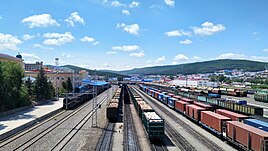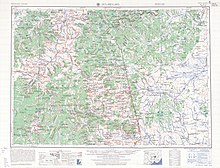| Suifenhe 绥芬河市 | |
|---|---|
| County-level & Sub-prefectural city | |
     Clockwise from top: Clockwise from top:Suifenhe Railway Station, Da Guangming Temple, "National Gate" on the China–Russia border, downtown Suifenhe, Central Square | |
 Suifenhe in Mudanjiang Suifenhe in Mudanjiang | |
 | |
| Coordinates (Suifenhe municipal government): 44°24′45″N 131°09′06″E / 44.4124°N 131.1518°E / 44.4124; 131.1518 | |
| Country | People's Republic of China |
| Province | Heilongjiang |
| Prefecture-level city | Mudanjiang |
| Township-level divisions | 2 towns |
| Municipal seat | Suifenhe Town (绥芬河镇) |
| Area | |
| • Total | 460 km (180 sq mi) |
| Elevation | 464 m (1,522 ft) |
| Population | |
| • Total | 100,000 |
| • Density | 220/km (560/sq mi) |
| Time zone | UTC+8 (China Standard) |
| Postal code | 157300 |
| Area code | 0453 |
| Climate | Dwb |
| Website | suifenhe |
| Suifenhe | |||||||||
|---|---|---|---|---|---|---|---|---|---|
| Simplified Chinese | 绥芬河 | ||||||||
| Traditional Chinese | 綏芬河 | ||||||||
| Postal | Suifenho | ||||||||
| |||||||||
Suifenhe (Chinese: 绥芬河) is a county-level city in southeastern Heilongjiang province, People's Republic of China, located where the former Chinese Eastern Railway crosses the border with Russia's town of Pogranichny, Primorsky Krai. In January 2014, Suifenhe became the only Chinese city in which trading with Russian Ruble is officially allowed. The city shares its name with the Suifen River, and is under the administration of Mudanjiang Prefecture-level City.
Suifenhe and the surrounding border areas were scenes of vicious combat when the Soviet Union invaded Japanese-occupied Manchuria in August 1945.
Geography and climate

Suifenhe has a monsoon-influenced humid continental climate (Köppen Dwb), with long, very cold, but dry winters, and warm, humid summers. The monthly 24-hour average temperatures range from −16.1 °C (3.0 °F) in January to 19.3 °C (66.7 °F) in July, and the annual mean is +3.17 °C (37.7 °F). Precipitation is light in the winter, and more than 2/3 of the year's precipitation occurs from June to September. With monthly percent possible sunshine ranging from 44% in July to 64% in January and February, the city receives 2,413 hours of bright sunshine annually, with the latter half of winter being especially sunny.
| Climate data for Suifenhe, elevation 568 m (1,864 ft), (1991–2020 normals, extremes 1951–2010) | |||||||||||||
|---|---|---|---|---|---|---|---|---|---|---|---|---|---|
| Month | Jan | Feb | Mar | Apr | May | Jun | Jul | Aug | Sep | Oct | Nov | Dec | Year |
| Record high °C (°F) | 5.1 (41.2) |
10.0 (50.0) |
17.0 (62.6) |
28.2 (82.8) |
31.7 (89.1) |
33.9 (93.0) |
35.3 (95.5) |
34.4 (93.9) |
29.6 (85.3) |
27.1 (80.8) |
17.5 (63.5) |
8.2 (46.8) |
35.3 (95.5) |
| Mean daily maximum °C (°F) | −10.5 (13.1) |
−6.0 (21.2) |
1.3 (34.3) |
11.2 (52.2) |
18.0 (64.4) |
22.1 (71.8) |
24.7 (76.5) |
24.2 (75.6) |
19.5 (67.1) |
11.6 (52.9) |
0.0 (32.0) |
−8.7 (16.3) |
9.0 (48.1) |
| Daily mean °C (°F) | −15.7 (3.7) |
−11.6 (11.1) |
−4.1 (24.6) |
5.2 (41.4) |
11.7 (53.1) |
16.4 (61.5) |
19.7 (67.5) |
19.1 (66.4) |
13.3 (55.9) |
5.5 (41.9) |
−5.0 (23.0) |
−13.5 (7.7) |
3.4 (38.1) |
| Mean daily minimum °C (°F) | −19.8 (−3.6) |
−16.3 (2.7) |
−9.1 (15.6) |
−0.6 (30.9) |
5.7 (42.3) |
11.1 (52.0) |
15.4 (59.7) |
14.9 (58.8) |
7.8 (46.0) |
0.2 (32.4) |
−9.2 (15.4) |
−17.4 (0.7) |
−1.4 (29.4) |
| Record low °C (°F) | −33.4 (−28.1) |
−31.0 (−23.8) |
−24.1 (−11.4) |
−13.0 (8.6) |
−4.3 (24.3) |
0.4 (32.7) |
6.9 (44.4) |
3.6 (38.5) |
−6.7 (19.9) |
−15.4 (4.3) |
−27.6 (−17.7) |
−32.3 (−26.1) |
−33.4 (−28.1) |
| Average precipitation mm (inches) | 8.4 (0.33) |
7.0 (0.28) |
17.1 (0.67) |
31.4 (1.24) |
76.7 (3.02) |
93.6 (3.69) |
124.7 (4.91) |
128.6 (5.06) |
68.7 (2.70) |
39.8 (1.57) |
22.9 (0.90) |
10.5 (0.41) |
629.4 (24.78) |
| Average precipitation days (≥ 0.1 mm) | 6.0 | 5.3 | 8.4 | 9.4 | 14.3 | 15.0 | 15.5 | 15.0 | 10.8 | 8.3 | 7.6 | 7.2 | 122.8 |
| Average snowy days | 9.0 | 8.7 | 12.1 | 7.3 | 0.7 | 0 | 0 | 0 | 0.1 | 3.3 | 9.7 | 10.8 | 61.7 |
| Average relative humidity (%) | 65 | 59 | 57 | 54 | 64 | 78 | 84 | 84 | 75 | 61 | 63 | 66 | 68 |
| Mean monthly sunshine hours | 175.4 | 188.3 | 216.7 | 200.3 | 215.8 | 209.9 | 192.8 | 193.4 | 217.4 | 203.9 | 161.2 | 155.1 | 2,330.2 |
| Percent possible sunshine | 61 | 64 | 58 | 49 | 47 | 45 | 41 | 45 | 59 | 61 | 57 | 57 | 54 |
| Source: China Meteorological Administration | |||||||||||||
Administrative divisions
Suifenhe administers two towns:
- Suifenhe Town (绥芬河镇)
- Funing Town (阜宁镇)
Transport
Road
Suifenhe is also a terminus of both G10 Suifenhe–Manzhouli Expressway and China National Highway 301, which run northwest to Manzhouli (Inner Mongolia), which is another China–Russia port-of-entry.
Road and rail border crossing

Suifenhe is one of the points where China's and Russia's railway systems connect through a rail border crossing on the Sino-Russian border. The rail line was originally constructed as the Chinese Eastern Railway in the early 20th century, but now serves as the terminus of the Harbin-Suifenhe Railway. The train station on the opposite side of the border is Grodekovo, in the town of Pogranichny, Primorsky Krai.
As of December 2009, Russian train schedule sites show the existence of the passenger train no. 401, making the 26-km trip between Suifenhe and Grodekovo twice a week; however, the twice-a-week trains no. 006, Khabarovsk–Harbin, and no. 967, Vladivostok–Harbin only have a scheduled stop in Grodekovo and not in Suifenhe.
The cross-border rail line is important for freight transportation. As of 2015, the main cargo entering China from Russia over this railway crossing is iron ore; at 1.3 million tons over the first 5 months of the year, it constitutes about 1/3 of the total import cargo volume.
The G10 Suifenhe–Manzhouli Expressway and China National Highway 301, which terminates at Suifenhe is connected via a road border crossing to Russia's A184 Highway. The nearest city to the crossing on the Russian side is Pogranichny.
References
- 中国金融信息网. "绥芬河卢布现钞使用试点进入正式实施阶段". 中国金融信息网. Retrieved 2021-02-27.
- "绥芬河试点使用卢布现钞-新华网". www.xinhuanet.com. Retrieved 2021-02-27.
- 中国气象数据网 – WeatherBk Data (in Simplified Chinese). China Meteorological Administration. Retrieved 27 September 2023.
- 中国气象数据网 (in Simplified Chinese). China Meteorological Administration. Retrieved 27 September 2023.
- 中国地面国际交换站气候标准值月值数据集(1971-2000年). China Meteorological Administration. Archived from the original on 2013-09-21.
- 2011年统计用区划代码和城乡划分代码:绥芬河市 (in Chinese). National Bureau of Statistics of the People's Republic of China. Retrieved 2013-02-18.
- "国家统计局" (in Chinese). National Bureau of Statistics of the People's Republic of China. Retrieved 2021-12-07.
- Russian train schedules site. One can search e.g. by entering "Grodekovo" as a station name, obtaining results like this: http://www.poezda.net/en/station_timetable?st_code=2034464&forDate=08-12-2009 The through trains from Khabarovsk and Vladivostok may in reality be just single cars, or groups of cars, attached to a train terminating in Grodekovo, and then passed on to the Chinese railways.
- 绥芬河铁路口岸2015年1至5月进口铁矿创历史同期新高] [Record amount of iron ore imported through the Suifenhe railway point of entry over the first 5 months of 2015]. houchepiao.com news.
| China–Russia border crossings | |
|---|---|
| County-level divisions of Heilongjiang Province | |||||||||||||||||||||||
|---|---|---|---|---|---|---|---|---|---|---|---|---|---|---|---|---|---|---|---|---|---|---|---|
| Harbin (capital) | |||||||||||||||||||||||
| Sub-provincial city |
| ||||||||||||||||||||||
| Prefecture-level cities |
| ||||||||||||||||||||||
| Prefecture |
| ||||||||||||||||||||||
| These are administrative zones, which are not standard units of local government, though they do function as such.
Formally part of Oroqen Banner in Inner Mongolia but administered de facto by Daxing'anling Prefecture in Heilongjiang. Formally part of Huma County. | |||||||||||||||||||||||